Before my time as a Clinical Educator with Motion Composites, I was an Occupational Therapist working in a community setting. I had the privilege of visiting clients in their home environments to assess and intervene with strategies that would assist them in maximizing their independence and safety and ideally allow them to stay in their home environment for as long as they desired. One of the reasons I valued this job was that every day was different; there was a wide variety of clients and environments – each one bringing its own set of challenges. I will say that quite a few of my favorite clients (if I am allowed to say that), the ones that stick with you throughout your career, had the diagnosis of MS. Why did they end up being so impactful on my career? Perhaps because of my time with them and their families over many years, sitting in living rooms, kitchens, and bedrooms evaluating their goals and prescribing equipment – everything from aids to daily living to complex rehabilitation technology. Maybe it was because of the nature of the condition that they tended to stay on my caseload for an extended period of time, or if I did discharge them, a few months or even a year or two later, they would pop back up with new goals and things we could work on. Either way, these clients are unique, and hopefully, through this, I can shed some light on things that work well for clients with MS from a product perspective.
Multiple Sclerosis is thought to be an auto-immune disorder in which the body will attack itself. With MS, the fatty tissue that surrounds nerves is destroyed and forms scar tissue called sclerosis or lesions. This causes damage to the nerves, and they are unable to conduct electrical impulses from the brain to the rest of the body. It is a chronic disease and is very unpredictable in how it will affect one person to another. Common symptoms include vision issues, muscle weakness, numbness, decreased coordination, spasticity, fatigue, as well as depression and cognitive and memory issues. These symptoms can range from mild to severe and can be short-term or long-lasting. This wide variety of symptoms and the unpredictable nature of this condition can bring some challenges from an equipment procurement perspective. When selecting equipment for someone with a progressive condition, there are a few things to help with the process, and things we can look for that can improve client satisfaction.
Always Empower & Educate
An important role of a therapist is to educate clients and their families about their conditions, treatment plans, and strategies to manage symptoms and maximize function. This will empower them to be leaders in their own care plans. Education can include teaching techniques for activities for daily living, exercises, and adaptive strategies to promote independence and improve quality of life. This education is not only for a current situation but also includes preparing for future issues. When equipment is being considered to assist with an issue that arises, all aspects of the device should be considered in partnership with the client/family. These equipment aspects will include the benefits, risks, costs, and alternative options, as well as addressing any other questions. Understanding these factors can help someone fully understand a device and assist in making decisions relating to that equipment, which will directly impact them.
Promote the Use of Equipment
Accepting the use of equipment to help with an activity that was previously completed without assistance can be a big step to take. It can make someone feel like they are giving up or incapable of independence. In my previous role, I introduced hundreds of people to equipment, allowing them to maintain activities they wanted to do. I see the use of equipment as something that allows independence, not takes it away. When a piece of equipment works for the client in their environment, it can give confidence through safety and autonomy to a task, and it usually allows a task to be maintained longer. Equipment related to MS can range from small tools to assist with daily living or a cane and walker for ambulation to complex rehabilitation equipment such as custom bathroom and toileting equipment or a manual and power wheelchair for mobility. A known benefit of properly prescribed equipment is energy conservation, allowing the client to direct their energy toward an activity that matters more to them. For example, a person may resist using a wheelchair in the home because they prefer the image of them using a walker even though it takes much more energy. Understanding that the use of a wheelchair in the home can conserve energy for later in the day, allowing the person to partake in more activities or visits with friends they would not have been able to do if they spent their energy on walking from room to room.
Prescribe for Today but Plan for Tomorrow
Just like products outside of the healthcare world, equipment can vary in its ability to be the right product for one person over another. Equipment in the healthcare industry should always be considered for what will work for the user today and in the foreseeable future. However, with the diagnosis of MS where the nature of the condition can be unpredictable, I believe we need to ensure we are providing equipment that can adapt to change. Motion Composites, NXT Seating, and RAZ Designs Inc. pride themselves on product adjustability, which means dialing in the product to fit an individual no matter the need. I am going to share a few examples from these product lines that could work well for someone trying to plan for their needs today and the unknown of tomorrow.
The HELIO A7:
For many reasons, the HELIO A7 is one of the most popular wheelchairs from Motion Composites, and there are many features that lend well to someone with MS. The features I am highlighting are not exhaustive, but ones I believe can have a significant impact.
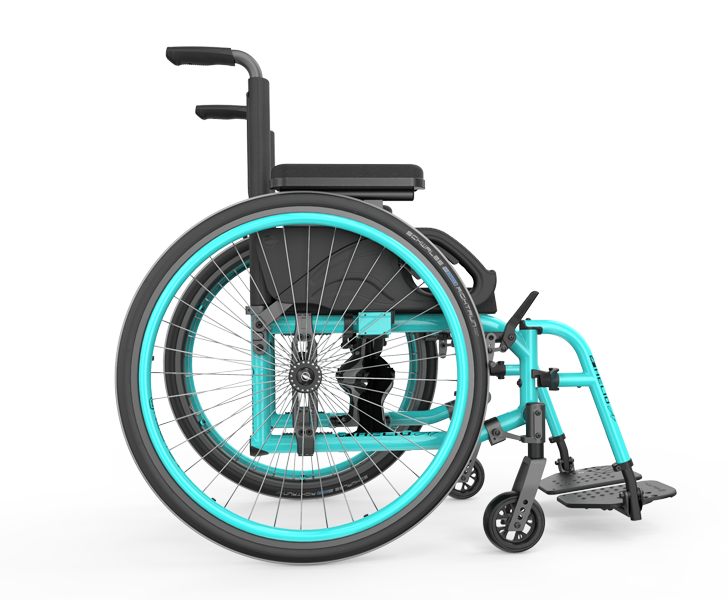
HELIO A7 Manual Wheelchair
- Full range of seat-to-floor heights: With its hybrid frame, this wheelchair can go from front seat to floor heights of 13”-21.5”. What this means is whether the client is arm propelling today but, in the future, feels more efficient foot propelling; or perhaps they are foot propelling today and become dependent for propulsion, this one frame can accommodate these changes for the ideal set-up. Smaller options and accessories such as casters, forks, or stem bolts may have to be exchanged, but this is minimal in cost and impact to the client compared to requiring a whole new device. There could come a time when someone was once a manual wheelchair user and will move to a power wheelchair. Being able to set up the original manual wheelchair for dependent use, transport or a back-up chair can be very valuable.
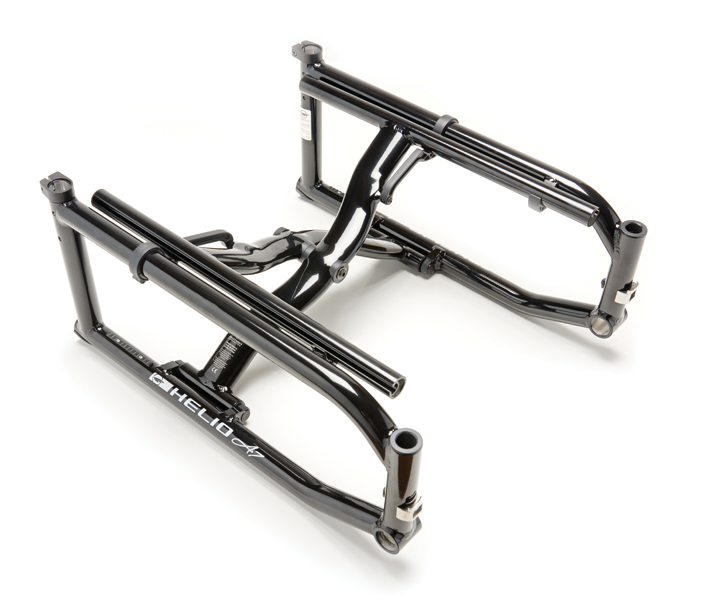 Hybrid Frame
Hybrid Frame
- Quarter-inch horizontal and vertical rear axle adjustments: Those who work with manual wheelchairs regularly know that the position of the rear wheels in comparison to the wheelchair frame, and therefore in relation to the person, has one of the biggest impacts on the usability of the wheelchair. There is a fine balance with this set-up, wanting the chair to be highly maneuverable while remaining stable for the specific user. The set-up varies from person to person depending on their body type and style of using the wheelchair, but also their comfort level and their wheelchair skills. Quarter-inch adjustments allow for precise set-up horizontally and vertically to allow the user to be in their specific ideal position for efficiency and safety without compromise.
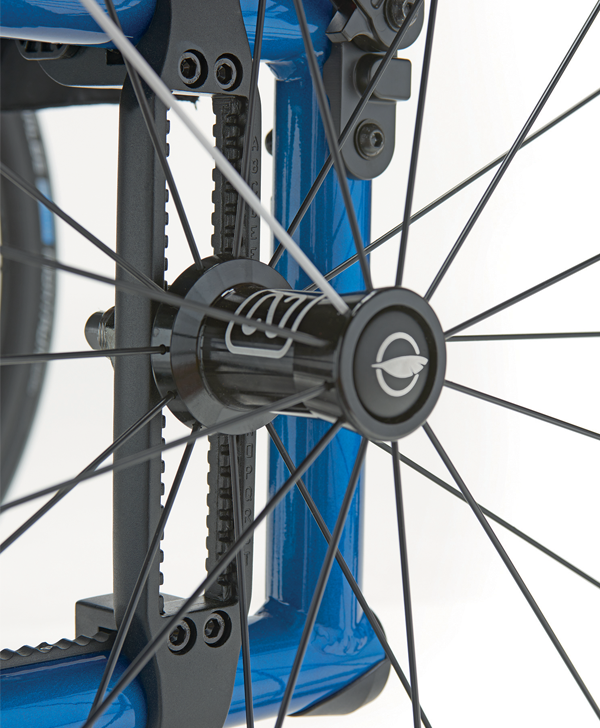
Axel Plate
- Full range of adjustability: The above-mentioned axel plate is not only adjustable in ¼” increments, it has a range of 12 different standard horizontal positions with a maximum center of gravity of 3.75”. The rear seat-to-floor height range of 12.5”-20.25” with the ¼” adjustments also allows for a full range of vertical rear wheel positions. Setting this wheelchair up to work ideally for a user with MS today is a breeze, and you have the assurance that as the client changes, the chair can change with them.
- Upgrade option to the HELIO C2: The HELIO A7 frame is made from 7000 series aluminum. This is a tried, tested, and very successful material in the manual wheelchair industry. There are other materials that can have an impact on the end user, one being carbon fiber, which is where the HELIO C2 comes in. The HELIO A7 and C2 are pretty much identical wheelchairs – but the difference is in the material. When a client wants to have the properties of carbon fiber like vibration damping, lightweight, high strength, and a lifetime warranty on the frame from Motion Composites, the HELIO C2 is available with all the same features of the HELIO A7 but the added benefits of carbon fiber.
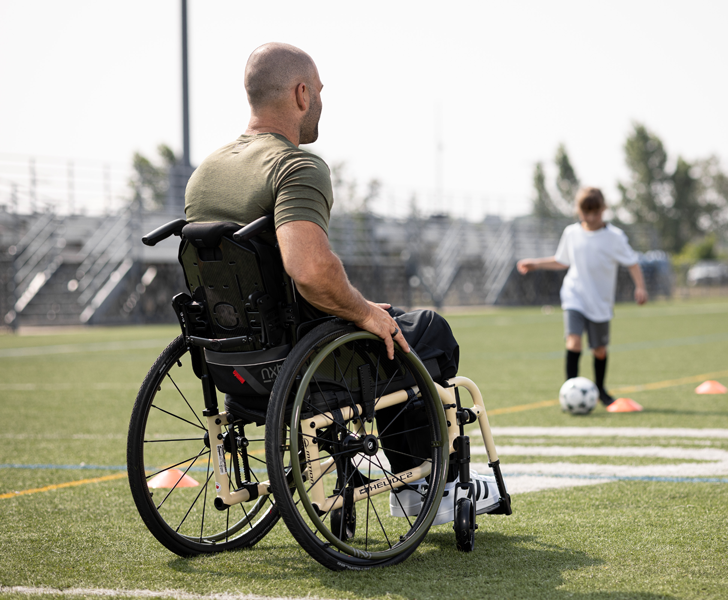
HELIO C2 Manual Wheelchair
Click here to learn more about the benefits of carbon fiber.
The NXT Xtend Back Support:
The Xtend is a unique back support in the industry. It can serve many purposes, but when it comes to a potential change in condition the NXT Xtend is a go-to for many.
- 4” of back length adjustability: This back support uses traditional hardware to fix to the wheelchair back canes just like any other. The unique part is that the top section of the back can be adjusted in length to allow for customization to the user. The Xtend length ranges from 16”-20” and the Xtend low from 13”-17”. This top section incorporates the lateral contours, which means we can place the support where it is needed most. A lower back support allows for more freedom of movement of the shoulder for independent arm propulsion, whereas taller backs allow for more support when positioning takes priority over independence.
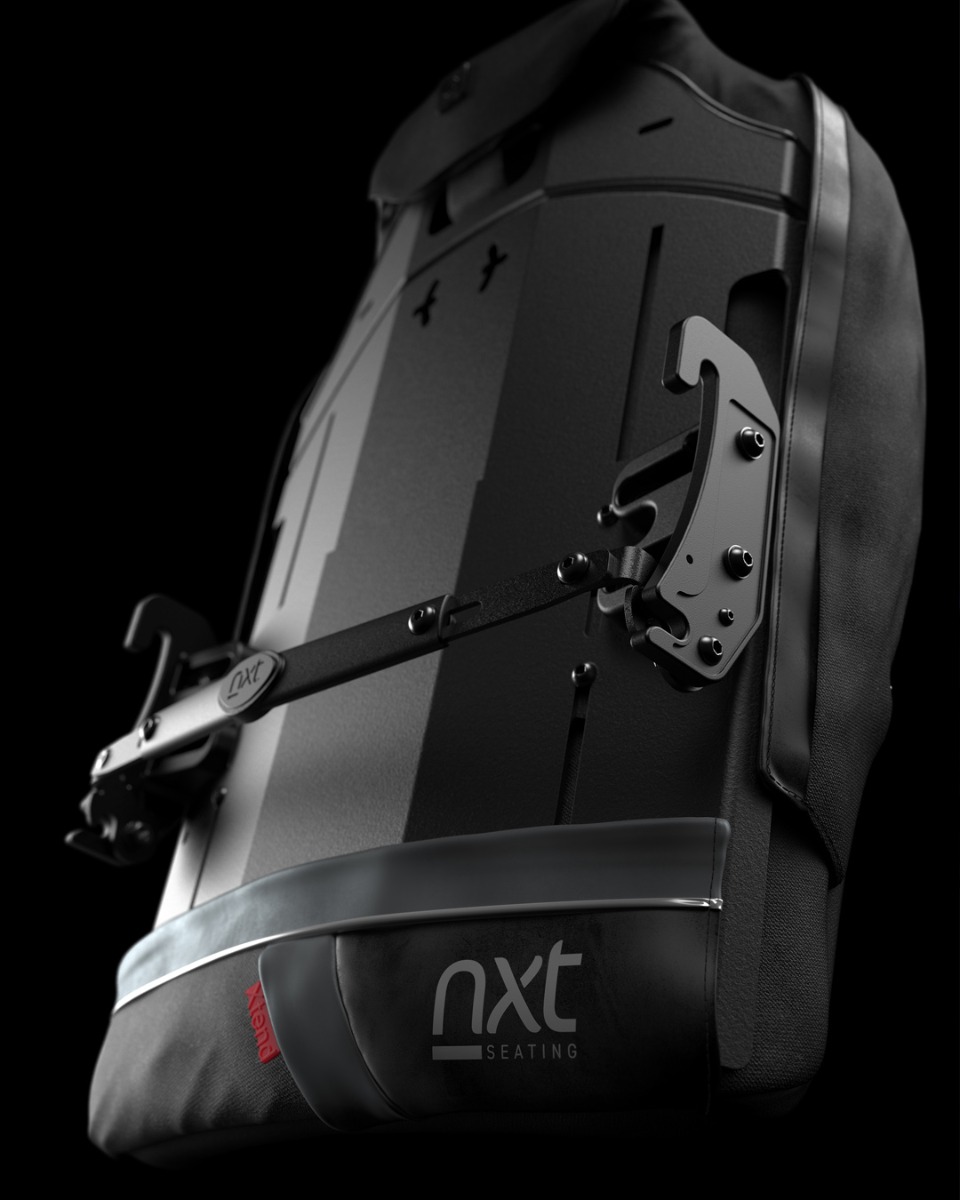
NXT Xtend Back Support
- One-hand release: A common feature of many NXT back supports is the one-hand release lever. When transporting a folding wheelchair, removing and re-installing an NXT back is easy due to the handle that controls the locking mechanism. One hand on the handle and it can easily be removed and installed. With a condition that can cause vision, coordination, balance, and energy problems, not fiddling with small tabs on the back support can make a big difference.
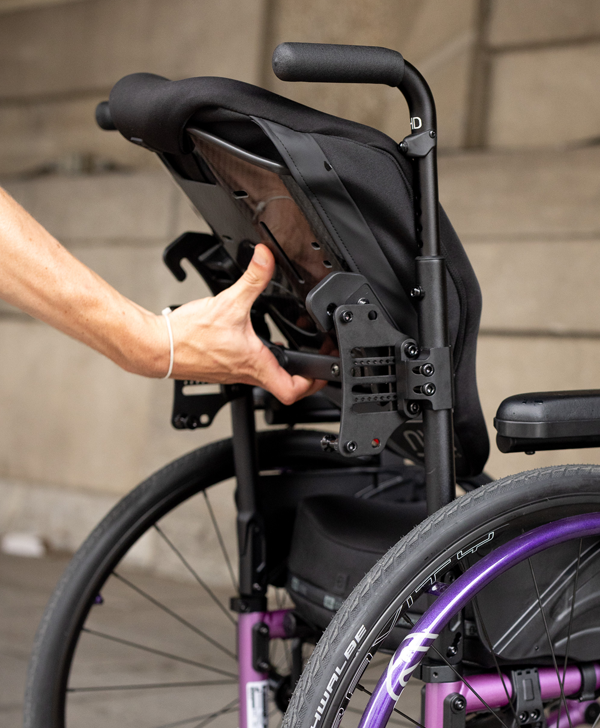
One-Hand Release
RAZ Mobile Shower Commode Chairs (MSCC):
In my opinion, RAZ MSCC are unmatched in the market for adjustability, options, accessories, and customizations to have a commode fit a specific user and environment.
- Variety in models: There is a model for pretty much any need, including self-propel, attendant propel, a variety of tilt options, bariatric options and travel options. The self-propel model, in which a user can independently propel the commode from bedroom to bathroom for toileting and showering, can change to an attendant propel if needed for a person dependent on mobility. This is easily done by removing the rear propel wheels and adding in two rear casters when someone is no longer independent and vice versa if someone desires independence. The key is adjustability with minimal additional cost instead of purchasing a whole new system.
- Seats and back supports for every need: Being able to individualize equipment is a known path to client satisfaction. Pressure relief allows for increased health and comfort for someone using a commode and being able to select from a wide variety of seat shapes and materials. Back options cannot only optimize pressure relief but also sitting tolerance. Not sure if there is a pre-made seat that is ideal for your client? They will customize one to your exact needs.
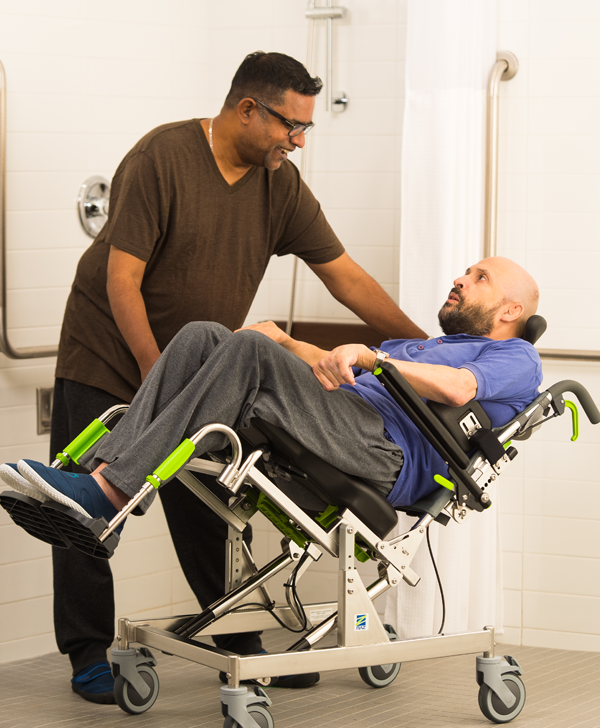
This is a small look into features, options and accessories that can make a big impact for a specific person. Sometimes in the world of Complex Rehab Technology, there are so many options or devices that on the surface seem the same. Details like those described above are the things that set one model apart from another and, in the end, make it the right product for someone. Understanding these details about a product and matching them with a client's needs will hopefully allow for the success of goals and client satisfaction.
Equipment procurement can be a difficult task, especially when the cost of items can be high. The MS society is there to assist not only with equipment but also education, advocacy, peer support, research, and so much more! As a therapist, I worked closely with my local MS society and, as a part of my education and empowerment encouraged all my clients to do the same.
MS Society Canada
National MS Society USA
Although professionally I am no longer working directly with clients with MS, I think fondly about the connections I have made, and I hope the things I have learned can help others as they continue with client care. We don’t get a crystal ball when we graduate school as a therapist or when we are diagnosed with a life-changing condition, but I believe there are things we can do so that when those changes do come, we are prepared and not left starting from scratch at each turn.
Reference
- What is multiple sclerosis? National Multiple Sclerosis Society. https://www.nationalmssociety.org/What-is-MS.





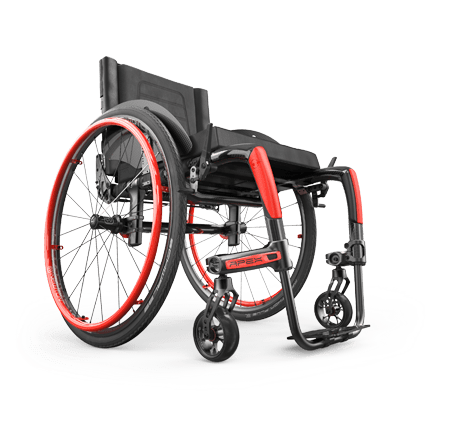
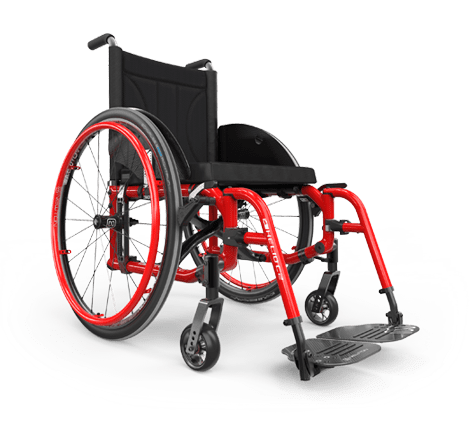


 Hybrid Frame
Hybrid Frame 




